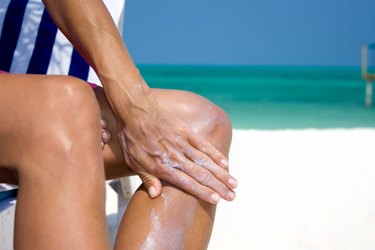
Rough, dark patches of skin on the knees are not unusual. Your knees bear the brunt of many physical activities. Children learning to crawl are very hard on their knees, as are the parents who kneel on the floor to interact with them at eye level. Generally speaking, rough patches of skin indicate dryness. While this may be a factor for many people who have darkened, mottled, bumpy skin on the knees, there are certain medical conditions that can also contribute to rough skin on the knees.
Flaking from Eczema
Video of the Day
Eczema is more than just dry skin, but the first signs on your knees might look like normal flaking. Eczema is a chronic skin condition, causing your skin to become rough, itchy and inflamed. Another term for eczema is atopic dermatitis -- an irritation of the skin stemming from unknown or nonspecific causes. Eczema can strike anywhere on your body, and according to Dermnet NZ, the knees are among the most commonly affected areas, particularly in toddlers. Corticosteroid creams and moisturizing agents can control inflammation and loss of moisture that can worsen symptoms.
Video of the Day
Itching and Redness of Psoriasis
Psoriasis is an autoimmune skin disease that can occur throughout your body, including the knees. Your skin begins to develop abnormally, making new skin cells faster than you can shed the old ones. When the cells accumulate, your skin becomes rough, scaly and thick. According to the National Psoriasis Foundation, the knees are a common location for scaly, roughened patches of skin to appear. Treatment for psoriasis includes topical medications to reduce inflammation and help your skin stop regenerating so quickly, moisturizing lotions and ointments to soften the skin to make exfoliation easier, and oral drugs to suppress your immune system.
Skin Wounds
You might develop rough patches of skin on your knees as the result of skin wounds. The knees often get scraped and cut, especially in children. Scabbing and scarring that takes place, including raised scars called keloids, can alter the texture of the skin on your knees and leave them rough during the healing process. The American Academy of Family Physicians advises you to leave scabs alone and let them fall off naturally rather than picking, as this is your body's way of caring for the wound. Keloid scars that form on your knees due to injury or surgery may require medical treatment to resolve the rough, bumpy patches of skin. Pressure bandages, laser treatments and surgical excision are all keloid scar-removal options that can restore smoothness to the skin on your knees.
Is this an emergency? If you are experiencing serious medical symptoms, please see the National Library of Medicine’s list of signs you need emergency medical attention or call 911.